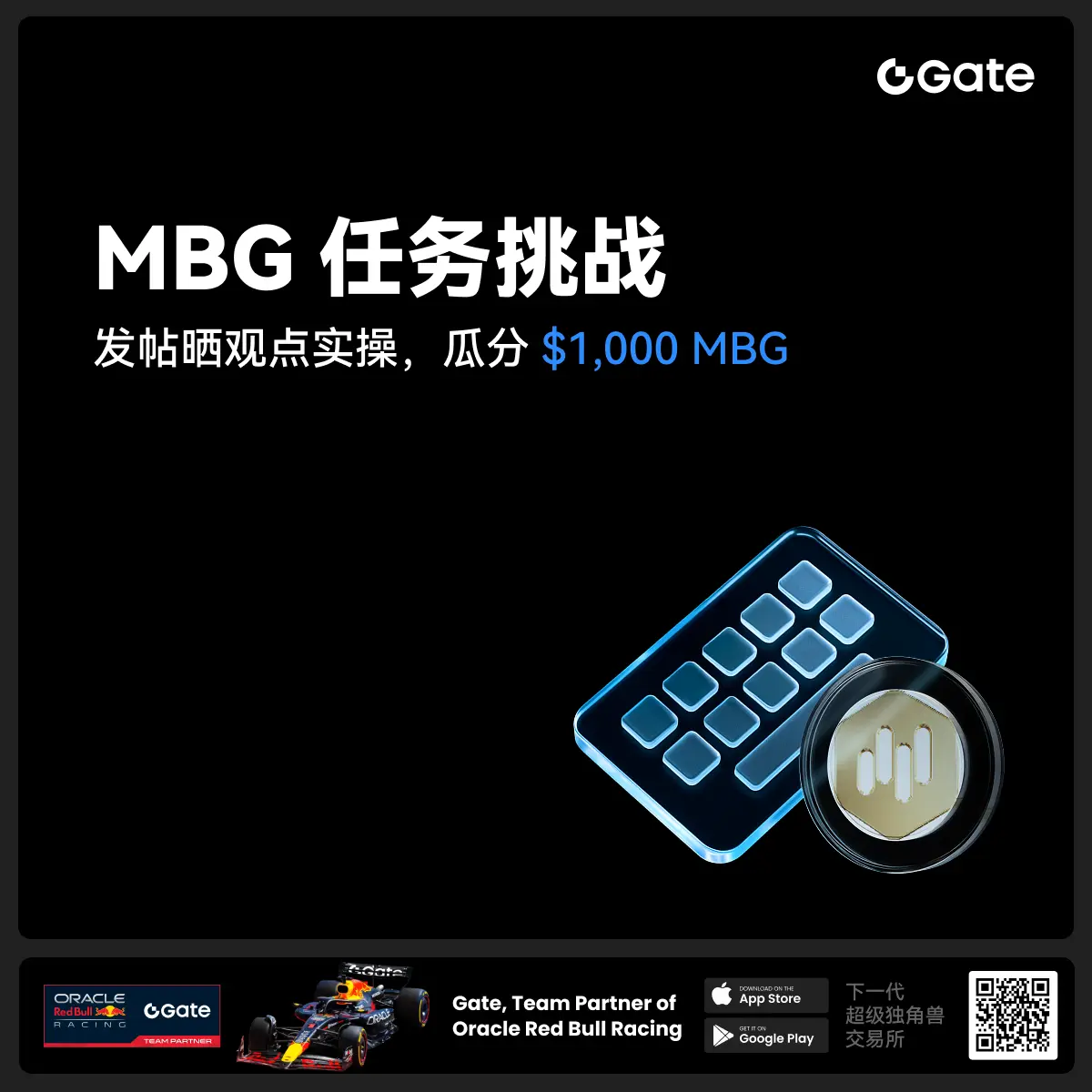- 话题1/3
17k 热度
14k 热度
7k 热度
6k 热度
45k 热度
- 置顶
- 📢 Gate广场 #MBG任务挑战# 发帖赢大奖活动火热开启!
想要瓜分1,000枚MBG?现在就来参与,展示你的洞察与实操,成为MBG推广达人!
💰️ 本期将评选出20位优质发帖用户,每人可轻松获得50枚MBG!
如何参与:
1️⃣ 调研MBG项目
对MBG的基本面、社区治理、发展目标、代币经济模型等方面进行研究,分享你对项目的深度研究。
2️⃣ 参与并分享真实体验
参与MBG相关活动(包括CandyDrop、Launchpool或现货交易),并晒出你的参与截图、收益图或实用教程。可以是收益展示、简明易懂的新手攻略、小窍门,也可以是现货行情点位分析,内容详实优先。
3️⃣ 鼓励带新互动
如果你的帖子吸引到他人参与活动,或者有好友评论“已参与/已交易”,将大幅提升你的获奖概率!
MBG热门活动(帖文需附下列活动链接):
Gate第287期Launchpool:MBG — 质押ETH、MBG即可免费瓜分112,500 MBG,每小时领取奖励!参与攻略见公告:https://www.gate.com/announcements/article/46230
Gate CandyDrop第55期:CandyDrop x MBG — 通过首次交易、交易MBG、邀请好友注册交易即可分187,500 MBG!参与攻略见公告:https://www.gate.com/announcements
- 🎉 Gate广场“星火计划”入驻KOL突破1000人!
💥 创作者生态迎来全面爆发期!
📈 上首页、拿奖励、赢影响力,你还在等什么?
💰 现金激励 ✔️
🚀 流量扶持 ✔️
👑 专属认证 ✔️
从0到1000,我们只用了短短数周,Gate广场正在成为Web3内容风暴眼⚡
你发布的不只是内容,而是下一个“爆款机会”!
🌟 加入星火计划,开启你的爆发之路!
👉 https://www.gate.com/announcements/article/45695
#GateSquare # #星火计划# #内容创作者新纪元 # #KOL集结令#
- 📢 #Gate广场征文活动第三期# 正式启动!
🎮 本期聚焦:Yooldo Games (ESPORTS)
✍️ 分享独特见解 + 参与互动推广,若同步参与 Gate 第 286 期 Launchpool、CandyDrop 或 Alpha 活动,即可获得任意奖励资格!
💡 内容创作 + 空投参与 = 双重加分,大奖候选人就是你!
💰总奖池:4,464 枚 $ESPORTS
🏆 一等奖(1名):964 枚
🥈 二等奖(5名):每人 400 枚
🥉 三等奖(10名):每人 150 枚
🚀 参与方式:
在 Gate广场发布不少于 300 字的原创文章
添加标签: #Gate广场征文活动第三期#
每篇文章需 ≥3 个互动(点赞 / 评论 / 转发)
发布参与 Launchpool / CandyDrop / Alpha 任一活动的截图,作为获奖资格凭证
同步转发至 X(推特)可增加获奖概率,标签:#GateSquare 👉 https://www.gate.com/questionnaire/6907
🎯 双倍奖励机会:参与第 286 期 Launchpool!
质押 BTC 或 ESPORTS,瓜分 803,571 枚 $ESPORTS,每小时发放
时间:7 月 21 日 20:00 – 7 月 25 日 20:00(UTC+8)
🧠 写作方向建议:
Yooldo
- 🎉Gate 2025 上半年社区盛典:内容达人评选投票火热进行中 🎉
🏆 谁将成为前十位 #Gate广场# 内容达人?
投票现已开启,选出你的心头好
🎁赢取 iPhone 16 Pro Max、限量周边等好礼!
📅投票截止:8 月 15 日 10:00(UTC+8)
立即投票: https://www.gate.com/activities/community-vote
活动详情: https://www.gate.com/announcements/article/45974
- 📢 #Gate广场征文活动第二期# 正式启动!
分享你对 $ERA 项目的独特观点,推广ERA上线活动, 700 $ERA 等你来赢!
💰 奖励:
一等奖(1名): 100枚 $ERA
二等奖(5名): 每人 60 枚 $ERA
三等奖(10名): 每人 30 枚 $ERA
👉 参与方式:
1.在 Gate广场发布你对 ERA 项目的独到见解贴文
2.在贴文中添加标签: #Gate广场征文活动第二期# ,贴文字数不低于300字
3.将你的文章或观点同步到X,加上标签:Gate Square 和 ERA
4.征文内容涵盖但不限于以下创作方向:
ERA 项目亮点:作为区块链基础设施公司,ERA 拥有哪些核心优势?
ERA 代币经济模型:如何保障代币的长期价值及生态可持续发展?
参与并推广 Gate x Caldera (ERA) 生态周活动。点击查看活动详情:https://www.gate.com/announcements/article/46169。
欢迎围绕上述主题,或从其他独特视角提出您的见解与建议。
⚠️ 活动要求:
原创内容,至少 300 字, 重复或抄袭内容将被淘汰。
不得使用 #Gate广场征文活动第二期# 和 #ERA# 以外的任何标签。
每篇文章必须获得 至少3个互动,否则无法获得奖励
鼓励图文并茂、深度分析,观点独到。
⏰ 活动时间:2025年7月20日 17
解读微策略MSTR最新财报:现持超25万枚BTC、三年内融资420亿镁加仓
MicroStrategy 计划在未来三年内融资 420 亿美元继续增持比特币,以此增强财务灵活性和市场竞争力。本文源自 MarsBit 的专栏文章《“不生产,只屯币”:MSTR 最新财报发布,揭秘 MicroStrategy 的资本增厚与高溢价估值模型》,由 Block Beats 整理、编译及撰稿。 (前情提要:微策略重磅宣布:未来三年要筹资420亿美元买BTC!迈向比特币银行) (背景补充:微策略无脑「杠杆做多」比特币,真的是好策略吗?) 历史上,每当一个传统行业走向巅峰时,往往会出现一些极具突破性的公司,它们在市场的夹缝中找到独特的「生产方式」,依靠独到的策略吸引资本。 这些公司很少「生产」实际的东西,却将资源集中到一种核心资产上 —— 像过去的壳牌石油公司通过石油储备维持估值、金矿公司依靠黄金开采和储备主导价格。而今天凌晨,MicroStrategy 的财报释出,让人再次看到这样一家公司:它不以「生产」著称,却凭借对比特币的巨额投资,打破了传统估值规则,并成了全球最大、最独特的比特币持有者之一。 从软体公司到比特币巨鲸:MicroStrategy 的转型之路 MicroStrategy(微策略),股票程式码 MSTR,这家公司原本是靠商业智慧软体打下的江山,然而创办人 Michael Saylor 却在 2020 年踩了油门,直接驶上了比特币的「快车道」。这年起,Saylor 不再让公司停留在传统的「生产」上,而是看中了比特币作为核心资产的潜力,开始将公司储备金一点点换成比特币,甚至押上了自己的身家,一步步把 MicroStrategy 打造成了比特币的「囤币银行」。在 Saylor 眼里,比特币就是数位世界的黄金,是全球金融未来的锚点。有人觉得他疯了,也有人称他是比特币的「狂热传教士」,但他却坚信,自己是在为公司赢得「新金本位」。 Saylor 并不打算走老路,他给 MicroStrategy 的定位更像是「空运快递」:相比传统 ETF 的「地面物流」,MicroStrategy 通过发债、借贷、股权增发等方式融资来直接购买比特币,灵活、高效,还可以追逐比特币市场的涨势。这让 MicroStrategy 不仅是一个股票程式码,更成了比特币市场的「快车标的」,公司市值直接与比特币的涨跌挂钩。Saylor 的操作引起了不小争议,知名投资人 Peter Schiff 甚至在社交平台 X 上调侃,「公司不生产任何产品,却靠囤比特币实现了超高市值」。他指出,MicroStrategy 的市值已超过大多数黄金矿业公司,仅次于纽蒙特公司。 对此,Saylor 的回应十分简单:「比特币是我们的未来储备资产。」在这种坚定信念的推动下,MicroStrategy 已积累超过 25 万枚比特币,还计划在未来三年内融资 420 亿美元用于继续增持。MicroStrategy 的「生产」方式不是传统的物质制造,而是围绕比特币的「基础设施」构建一种新型金融系统。 有人说 Saylor 是在赌,但或许,这不仅是赌注,而是一种信仰。他用一场冒险走出一条另类之路,让 MicroStrategy 成为了金融市场中的另类标的。正如他所说的那样:「我们不生产,我们只是『屯币』。」 MSTR 最新财报解读:资本增厚与比特币储备再加码 1. 财报整体概况与融资计划 MicroStrategy 本次释出的财报整体呈现出利好预期。公司计划在未来三年内融资 420 亿美元,用于继续增持比特币,同时已完成对之前质押比特币的回购。截至财报日期,MicroStrategy 共持有 252,220 枚比特币。 自 2024 年第二季度结束以来,公司新增购入 25,889 枚比特币,总成本约为 16 亿美元,平均价格为每枚 60,839 美元。目前公司总市值约为 180 亿美元,累计购入比特币的成本为 99 亿美元,平均价格约为每枚 39,266 美元。公司还通过 A 类普通股销售筹集了 11 亿美元,并通过发行 2028 年到期的可转换债券再筹集了 10.1 亿美元,同时偿还了 5 亿美元的高阶担保票据,解除所有比特币资产的抵押。这一解除抵押的举措显著增强了公司的财务灵活性,降低了其在极端市场条件下的风险。 2. 现金储备与未来融资目标 MicroStrategy 当前持有 8.36 亿美元的现金,为未来进一步购买比特币提供了稳定的资金支援。公司还发布了分阶段的融资目标:2025 年计划融资 100 亿美元,2026 年为 140 亿美元,2027 年为 180 亿美元,总计 420 亿美元。CEO Michael Saylor 的这一计划旨在通过分步增持比特币强化公司的核心资产储备,这无疑被市场视为利好,而非负面讯息。 3. 市值与帐面价值 截至 2024 年 10 月 29 日,MicroStrategy 的市值约为 180 亿美元,帐面价值则为 69 亿美元,这一资料已扣除 30 亿美元的累计减值损失。减值原因并非 MicroStrategy 出售了比特币,而是基于现行会计准则下的帐面调整。根据会计规定,如果比特币在某一季度的市场价格下跌,公司必须将这些资产的帐面价值调低,并计入减值损失。然而,即便后续价格回升,帐面价值不会自动恢复,只有在出售时才能体现升值。若未来会计准则的修改(如 FASB 的公允价值计量通过)得以落地,这一问题将有望得到改善。 4. BTC 作为核心资产的灵活性优势 作为核心资产,比特币相比现货 ETF 赋予 MicroStrategy 更高的资本运作灵活性。公司将其比特币储备运营比作石油公司的石油储备。就像石油公司处理未提炼与已提炼产品(如汽油、柴油、航空燃油)一样,MicroStrategy 也将比特币储备视作一种资本保值工具,通过这一核心资产,公司得以提升生产力并实施创新的金融策略。 5. MicroStrategy 的比特币持有原则 MicroStrategy 对比特币持有制定了八项核心原则,反应出其...